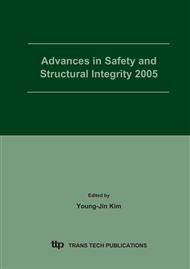p.55
p.63
p.71
p.79
p.89
p.97
p.105
p.111
p.117
Quantification of Crack-Tip Constraint Effect on Master Curve Reference Temperature Based on Two-Parameter Approach
Abstract:
The master curve has evolved into a mature technology for characterizing the fracture toughness transition of ferritic steels. However, it is well known that the master curve reference temperature (To) values estimated from small laboratory specimen may be biased low due to loss of crack-tip constraint. To quantify such variations of To resulting from differences of crack-tip constraint of testing specimen, two-parameter fracture mechanics approaches are employed in the present study. In this context, fracture toughness test and 3-dimensional finite element (FE) analysis for several standard and nonstandard test specimens are performed to quantify relationship between variations of To and constraint parameters and to find best constraint parameter representing effect of crack-tip constraint on To values evidently. Based on testing and present FE results, To and constraint parameter loci are constructed and engineering To correlation models considering crack-tip constraint are suggested
Info:
Periodical:
Pages:
89-96
Citation:
Online since:
March 2006
Authors:
Price:
Сopyright:
© 2006 Trans Tech Publications Ltd. All Rights Reserved
Share:
Citation:


